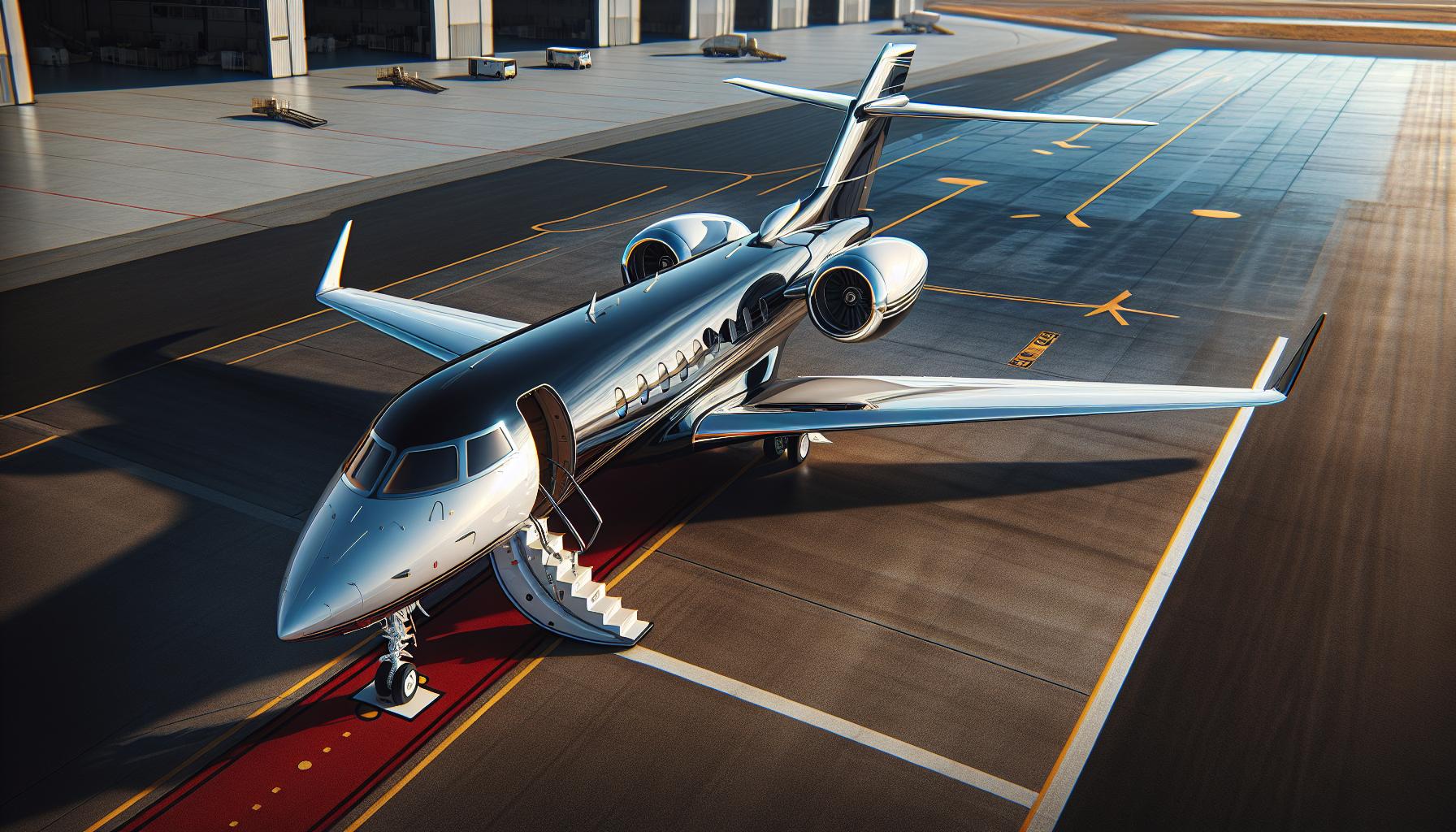
Ever wondered what it costs to own a slice of the sky? I’ve spent years in the private jet business, and I’m here to give you the inside scoop on the price tag of a midsize private jet. Trust me, it’s a question with a lot of zeroes!
Buying a jet isn’t like picking out a new car; it’s a whole different ballgame. Stick around and I’ll break down the figures that’ll make you an informed jet shopper. With my well-researched insights, you’ll soon understand the true cost of flying in style.
Factors that Affect the Cost of a Midsize Private Jet
When diving into the private aviation market, I’ve learned that the price tag of a midsize private jet can vary dramatically. This isn’t just about the initial cost of purchase but also the ongoing expenses that come with jet ownership.
Brand and Model: Not all jets are created equal. Just like cars, brands carry their own prestige and quality levels. Some of the top manufacturers like Gulfstream or Bombardier may command higher prices due to their reputation for luxury and technology.
Age of the Jet: The age of a jet is a critical factor. A brand new model can cost significantly more than one that’s even just a few years old. Depreciation hits jets just like it does with cars, though often at a steeper curve due to the technology advancements in newer models.
Flight Hours: The number of hours a jet has flown is akin to the mileage on a car. A jet with fewer flight hours under its belt will generally be pricier, as it’s likely to have less wear and tear.
Maintenance History: A well-maintained jet can save a fortune in the long run. I always look for a thorough maintenance record, which can be a testament to the aircraft’s reliability and potentially reduce future repair costs.
Customizations and Upgrades: Any added features or customizations can jack up the price. Features like enhanced avionics, upgraded interiors, or bespoke fittings make the jet more appealing but also more expensive.
Operational Costs: Beyond the sticker price, it’s important to factor in the annual operating expenses. Stuff like fuel, insurance, storage, and crew salaries can add up quickly. In my experience, these can often be a key determinant in the real cost of jet ownership.
By understanding these factors, prospective buyers can navigate the market more effectively. I’ve seen clients make more informed decisions which ultimately lead to their satisfaction with their midsize private jet investment.
Understanding the Price Range for Midsize Private Jets

When you’re in the market for a midsize private jet, the sticker price can vary dramatically. I’ve noticed that brand-new jets might set you back anywhere $20 million to $60 million, depending on the make and model. Now, if you’re looking at pre-owned options, the price can drop significantly. For a used jet, you’re generally looking at a range of $5 million to $35 million.
Key Factors Affecting Jet Prices
A few factors consistently play into these pricing variances:
- Brand and Model: Some manufacturers are synonymous with luxury and command a higher price.
- Jet Age: Newer jets come with the latest technology and safety features, which can drive up the cost.
- Customizations: Think bespoke interiors or state-of-the-art entertainment systems; these add-ons up the ante on pricing.
Knowing the age of a jet is vital. Aircraft depreciate, and the depreciation curve varies. For instance, a five-year-old jet might be roughly 20-30% less expensive than its brand-new counterpart.
Operational Costs to Consider
Aside from the acquisition cost, running a midsize private jet isn’t cheap. Fuel, pilots, hangar fees, and maintenance are part of the package. Here’s a brief breakdown of estimated annual operational costs:
| Expense Type | Estimated Annual Cost |
|---|---|
| Fuel | $400,000 – $900,000 |
| Maintenance | $100,000 – $300,000 |
| Crew Salaries | $150,000 – $300,000 |
| Insurance | $20,000 – $50,000 |
| Hangar Fees | $20,000 – $40,000 |
Keep in mind that flying more often increases these costs proportionally. Also, if you’re not flying enough, lack of use can also lead to increased maintenance needs. It’s a delicate balance that necessitates careful planning and budgeting.
Remember, I’m not just pulling numbers out of thin air. I’ve spent years researching and staying on top of industry standards to bring you accurate, useful information. When you know the factors that contribute to the costs of owning and operating a midsize private jet, you’re better equipped to make smart, informed decisions catered to your needs and lifestyle.
The Hidden Costs of Owning a Midsize Private Jet

When considering a midsize private jet, it’s essential to dig beyond the surface. I’ve noticed that prospective owners often overlook some less obvious expenses that can accumulate over time. I’ll highlight a few of these costs to give you a clearer picture of what to expect.
Depreciation is a sneaky expense. The moment a new jet leaves the showroom, its value starts to drop. For midsize jets, this depreciation can be steep in the first few years. It’s not just about age; factors like market demand and advancing technology also drive a jet’s resale value down. I’ve seen owners surprised by how much their asset can depreciate when it’s time to sell or upgrade.
Next, I’ll talk about downtime costs. These are the expenses related to the aircraft not being in use, and they’re often underestimated. For instance, if your jet is grounded for maintenance, you’re not just paying for repairs but also losing potential charter income if you rent it out. These costs can add up, especially during extensive overhauls which are not uncommon with complex machinery like jets.
Don’t forget about crew training. Pilots and cabin staff require regular training to stay certified, which involves simulator time, classroom learning, and in-flight training. And it’s not just about safety – it’s also a regulatory requirement. These training sessions aren’t free, and skipping on them is not an option.
Lastly, let’s touch on upgrades and customizations. As an owner, you might want to add personal touches or stay current with the latest avionics and comfort features. Whether it’s a new entertainment system or upgraded navigation tools, these enhancements ensure your jet meets your needs and keeps its edge in the resale market.
By keeping these hidden costs in mind, I ensure my financial planning for jet ownership is as precise and realistic as possible. It’s all about knowing what to expect and budgeting accordingly.
Financing Options for Midsize Private Jets

When you’re eyeing a midsize private jet, it’s crucial to explore your financing options. From traditional loans to leasing agreements, there’s a variety of ways to manage the cost. I’ll help you understand some of the most common approaches to financing your dream jet.
Traditional Loans are the go-to choice for many. Most banks and financial institutions offer aviation financing with terms that can extend up to 20 years. The interest rates and loan terms depend on factors such as creditworthiness and the age of the aircraft.
- Lease Agreements present an alternative to traditional loans. These can be:
- A “wet lease,” which includes the aircraft and a crew.
- A “dry lease,” which provides the aircraft alone.
Leasing can be a smart move if you prefer to avoid outright ownership due to depreciation concerns.
Fractional Ownership is gaining traction too. It involves multiple owners sharing the cost and use of the jet. This can significantly reduce individual expenses while still providing access to a private aircraft.
For those looking to own a jet without the steep upfront cost, Jet Cards and Membership Programs offer a compromise. You pay for flight hours in advance and use them as needed, without worrying about the day-to-day costs of jet ownership.
Remember, each financing option carries its own set of implications for cash flow and taxes. It’s important to consult with a financial advisor who specializes in aviation to choose the best route for your financial situation. They’ll help you navigate the complex landscape of aircraft financing, ensuring you make an informed decision that aligns with your long-term financial plans.
It’s evident that the path to owning a midsize private jet isn’t limited to just writing a colossal check. With the right financing strategy, that sleek, gleaming jet on the tarmac could be well within your reach.
Conclusion
Frequently Asked Questions
What are the financing options for owning a midsize private jet?
You can consider traditional loans, lease agreements, fractional ownership, and jet cards or membership programs to finance a midsize private jet. Each option has different cash flow and tax implications.
Is it necessary to consult a financial advisor for aviation financing?
Yes, due to the complexity of aviation financing and its associated tax implications, consulting with a financial advisor who specializes in aviation is highly recommended.
Can I own a private jet without paying the full price upfront?
Yes, with options like leases, fractional ownership, and jet card programs, you can access private jet travel without paying the full purchase price upfront.
Are there any tax advantages to financing a private jet?
Yes, depending on the financing method, there may be tax advantages. However, specific benefits depend on individual circumstances and tax laws, so professional advice is essential.
Is owning a midsize private jet restricted to outright purchases?
No, outright purchases are not the only way to own a midsize private jet. There are various financing strategies available that can make ownership more accessible.
